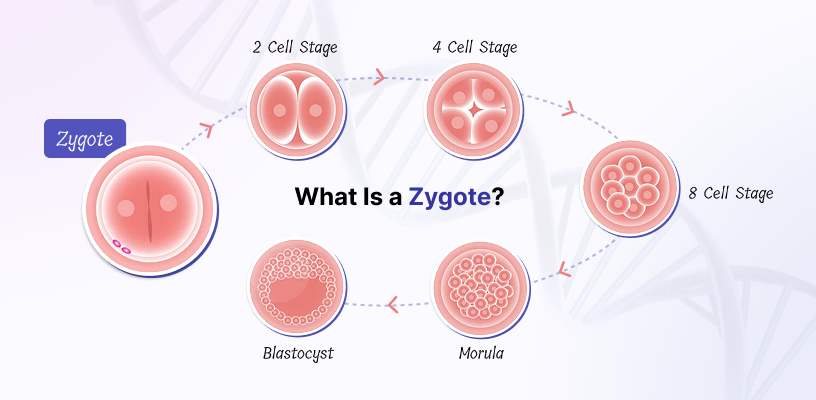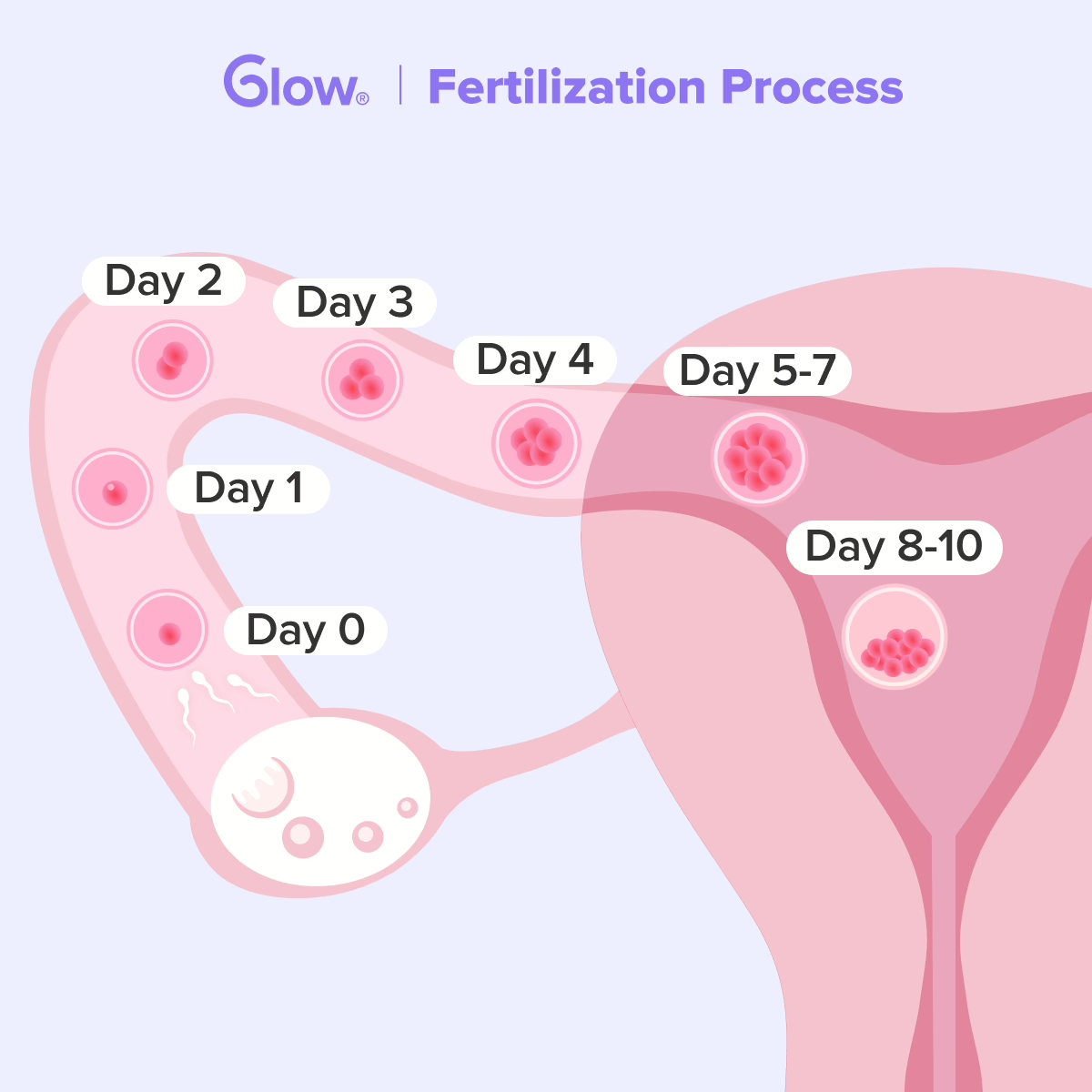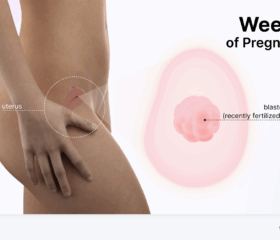What Is a Zygote? What First-Time Parents Need to Know
While conception is impossible to notice when it happens, it’s a significant step on your journey to motherhood.

Big changes are happening inside of you, and they all revolve around a single cell called a zygote.
Let’s explore exactly what a zygote is, how your baby will develop from this single cell, and some rare but potential complications to be aware of at this stage of pregnancy.
What is a zygote?
A zygote is a single fertilized egg cell. It’s created when an egg from a woman is fertilized by a sperm from a man.
Each zygote contains 23 chromosomes from the egg and 23 chromosomes from the sperm. This genetic material provides the developmental blueprint and instructions for your baby. 1 2
What is a gamete?
You may hear the term “gamete” referred to in discussions of zygotes. A gamete is a reproductive cell. In a woman, it’s an egg; in a man, it’s sperm. The two come together to form a zygote.
Each cell carries a single set of 23 chromosomes. It’s only when the sperm fertilizes the egg that the zygote gets a complete set of 23 pairs of chromosomes needed for human development. 3
How does a zygote form?
This first stage of development is short and, technically, not even part of pregnancy. Here are all the steps involved in the formation of the zygote, from ovulation to implantation:
Eggs are released during your menstrual cycle
Eggs live in a woman’s ovaries. During her menstrual cycle, some of these mature. The hormones released at this time also prepare the body for fertilization, making the uterus thicker and spongier.
Around the halfway mark of the menstrual cycle, one of the unfertilized eggs exits the ovary. The egg slowly moves through the fallopian tube and approaches the uterus. This process is called ovulation. 4
During sex, sperm attempt to reach the egg. If a woman has sex during this time and a man ejaculates inside her, this is when fertilization can take place.
On average, a man’s semen contains millions of sperm when he ejaculates. Many of these sperm swim past the cervix and up the fallopian tube, attempting to penetrate the egg. However, only one of them needs to succeed. 5
The woman’s body helps the sperm along, too. When she ovulates, her cervical mucus gets clear and stretchy. This creates a protective environment for sperm to move through. 6
The egg and sperm join
When a sperm successfully penetrates the mature egg, the two join to become a zygote. Chemical changes then transform the outer layer of the egg to prevent any other sperm from penetrating it.
The timing of this can be tricky. A released egg only lives for about 24 hours. Sperm can live for about 5 days (on average) inside of a woman. This means that for the best chance of conception, you should have sex within the 5-day period prior to ovulating (ideally on multiple days). 7
If conception is successful and a zygote is formed, the next thing that will happen is that it will move down the fallopian tube, aided by cilia. These are hair-like tissues inside the tube that push the zygote to the uterus.
The zygote divides and becomes an embryo
During this time, the zygote will begin to double and divide. This ball of cells it forms is called a blastocyst. It’ll take several days to reach the uterus. When implantation occurs (the moment the zygote implants into the uterine lining), the blastocyst becomes an embryo. 1 8

What if you use assisted reproductive technology?
Sex isn’t the only way to make a baby, and it might not always be a feasible option. Many women also use assisted reproductive technology (ART) to conceive. There are two main methods:
- Intrauterine insemination (IUI): A doctor takes sperm from the male partner or a donor and directly implants it into the uterus of the woman while she’s ovulating. 9
- In vitro fertilization (IVF): Eggs and sperm are taken from the partners or donors and combined together in a lab setting. The fertilized egg is grown in an incubator that simulates the environment of the fallopian tubes. Once the zygote reaches the blastocyst stage, it gets placed inside the woman’s uterus for implantation. 10
ART methods are commonly used to treat people dealing with factors negatively affecting their fertility. In the US, this is quite common, with 19% of married women under the age of 49 being unable to conceive after a year (and 26% of those same women struggling to carry a baby to term). 11
When else might you need assisted reproductive technology?
While ART is commonly used in cases of infertility, it’s also used when a medical condition prohibits a couple with healthy eggs and sperm from conceiving (like erectile dysfunction).
These kinds of procedures can also be used by same-sex couples or single parents who can’t conceive naturally.
How does the zygote develop if you’re having twins?
Twins and other multiple births occur when fertilization deviates from the norm. How it happens also determines whether you’ll have identical or fraternal twins:
Identical (monozygotic) twins
The initial formation process is the same as with a single birth. However, within the first week or two of fertilization, the single zygote divides into two.
Because these two zygotes come from the original zygote, they carry the same genetic information, which is why the twins they grow into will be nearly identical in appearance. 12
For every 1,000 births that happen, 3 to 4 of them feature identical twins. Genetics typically don’t play much of a role when it comes to the odds of developing monozygotic twins, although it’s more common in ART situations. 13
Fraternal (dizygotic) twins
This process is different from the get-go. Instead of just one egg being fertilized, two or more eggs get fertilized by different sperm during the same ovulation cycle.
As a result, two zygotes are formed. However, they won’t have identical sets of DNA. They’ll have similarities the way that all siblings do, but they won’t look quite as alike as identical twins. 12
The zygotes of fraternal twins may even be fertilized at different times based on when the eggs are released. 14
For every 1,000 births, 6 to 8 of them will result in fraternal twins. The odds of conceiving dizygotic twins tends to have a genetic component. For instance, if you have a close relative who had fraternal twins, you’re twice as likely to have them as the general population. 15 16
What are the first stages of prenatal development?
How does the zygote eventually become your baby? Every pregnancy is different, and the same goes for your baby’s rate of development.
There are three stages that embryos go through during early prenatal development, but it’s a gradual and continuous process and may differ slightly from one woman to the next.
Stage 1: From zygote to blastocyst
Within hours of fertilization, the single-cell zygote starts cleaving (dividing) via a process called mitosis. 17
- Within 24 hours, there will be 2 cells
- Within 2 days, there will be 4 cells
- Within 3 days, there will be 12 cells
About four days after fertilization, 16 cells form, known as the morula. This name comes from the Latin word “morum,” meaning mulberry—which is exactly what this tightly-packed cluster resembles. 18
The morula isn’t just a cluster of cleaved cells. It’s a mass of 16 to 32 cells and is surrounded by what’s known as the zona pellucida. 19
Around day five, the blastocyst begins to form. This is when the embryo has around 150 cells and begins to push at the zona pellucida. 20 At the same time, the inner part of the blastocyst fills with fluid.
Once the zona pellucida ruptures, the blastocyst hatches from it. There are two main components to the blastocyst. The inner cell mass inside the blastocyst is where the fetal cells live and grow. The outside of the blastocyst contains trophectoderm cells that become the placenta and protect your fetus. 21 1
Stage 2: From blastocyst to embryo
Around 5 to 6 days after fertilization, the blastocyst reaches its destination and implants itself within the nutrient-rich endometrium (uterine lining). 17
Some of the placenta cells begin to create an outer membrane known as a chorion. Other cells create an inner membrane known as an amnion. This inner membrane becomes the amniotic sac around day 10 or 12. Over time, it will fill up with liquid and expand as it encases and supports your embryo.
When the implantation process is complete, usually by day 9 or 10, the blastocyst becomes an embryo. 22
Stage 3: From embryo to fetus
During this stage, the embryo experiences rapid development. It grows much larger, and also starts to form your baby’s body and internal structures. 23
Embryonic development timeline
| Week | What’s growing | Notable milestones |
|---|---|---|
| 5 | - External features - Blood cells - Kidney cells - Nerve cells - Brain - Spinal cord - Heart - Gastrointestinal tract |
This is the start of the embryonic period. It’s also when your baby is most at risk for damage that can cause birth defects. |
| 6–7 | - Arm and leg buds - Further brain development - Cranial nerves - Eyes - Ears - Spinal tissues and other bones |
The embryo’s heart grows, and its rhythm becomes more steady. It can be seen on an ultrasound.
Blood starts pumping through the vessels. |
| 8 | - Arms and legs - Hands and feet - Further brain development |
Your baby’s lungs begin to form. |
| 9 | - Nipples - Hair follicles - Toes - Essential organs |
Arms and legs have fully developed. |
| 10 | - Eyelids - Outer ears - Distinctive facial features - Intestines rotate |
Eyes will start blinking.
Your baby’s heartbeat can now be picked up by a Doppler monitor. |
It’s around week 10 when your embryo will become a fetus. With the exception of your baby’s brain and spinal cord, almost every other organ has developed by this point.
By week 12, your baby will fully fill the uterus. The uterus and your baby continue growing together until you give birth.
Practice good habits to keep your baby safe
Your baby is most vulnerable at this stage of development. He’s at a high risk of damage from external factors like viral infections, radiation, medication, and alcohol and drug use. If he’s exposed to any of these, this increases the risk of him developing congenital malformations.
What are the potential complications during the zygote stage?
The zygote stage is the briefest one during pregnancy. It’s also a very delicate stage in prenatal development when pregnancy loss can occur.
The risks of early miscarriage
About 80% of miscarriages take place in the first trimester, with most happening before 10 weeks. 24 Roughly 10% of women who’ve learned they’re pregnant experience an early miscarriage. 25
This rate goes up if you confirm your pregnancy with a home pregnancy test close to when you expect your period. Some studies suggest that miscarriage rates are actually as high as 30%, since some happen before a woman even knows she’s pregnant. 26
What increases the risk of miscarriage?
Miscarriage is much more common at this stage than others. Most of the time, miscarriages are caused by genetic abnormalities in the embryo. However, the rate of incidence can go up due to factors such as: 27 28
- Being over 35 (women over 45 are most at risk)
- Having a long-term health condition (e.g., diabetes, lupus, or high blood pressure)
- Being over or underweight
- Drinking alcohol while pregnant, or smoking or drinking too much caffeine
Fortunately, once you get past week 12th, your risk of pregnancy loss significantly drops. After the first trimester, the risk of miscarriage goes down to about 1%–2%. 29
Common causes of miscarriage at this stage
Biologically speaking, there are a number of contributing factors that can lead to different types of miscarriage and pregnancy loss:
Chromosomal abnormalities
There are different kinds of abnormalities, including:
- Monosomy: This means one of the zygote’s chromosomes has been deleted.
- Trisomy: This means that one chromosome or a pair of chromosomes gets duplicated and creates too much genetic material.
- Translocation: This happens when part of a chromosome breaks off and reattaches to another chromosome (which essentially results in an extra chromosome).
These abnormalities can result in miscarriage or cause developmental disabilities. For instance, trisomy 21 causes Down syndrome. 30
Chromosomal abnormalities are the most common reason for pregnancy loss, with roughly 50% of cases caused by this. When they happen super early in the pregnancy, some women aren’t even aware they miscarried, as miscarriage symptoms can appear similar to a period.
Your risk of experiencing this type of miscarriage goes up with age. For instance, these are the rates based on age: 25
- 9%–17% for 20- to 30-year-olds
- 20% for 35-year-olds
- 40% for 40-year-olds
- 80% for 45-year-olds
Having had an early miscarriage before can also increase the statistical likelihood of it happening again. 25
Insufficient uterine lining
For the zygote to implant successfully, the endometrium needs to be properly thickened and prepared. If the uterine lining isn’t sufficiently developed, the zygote may fail to implant.
If the zygote doesn’t implant, you will naturally shed the endometrium and zygote during your next period. 28
Biochemical pregnancy
In this case, the zygote makes it all the way to the implantation stage. However, just after beginning to implant itself in the uterine wall, development stops.
Because of how far it progresses, your body may start to produce human chorionic gonadotropin (hCG). hCG is a hormone that a woman’s body produces when she’s pregnant. It can show up in blood or urine within 10 days of conception. 31
Most pregnancy tests won’t be able to detect hCG until you experience a late period. However, taking a home pregnancy test too early can give a false positive, like in the case of a biochemical pregnancy.
Ectopic pregnancy
Not all zygotes make it to the uterus for implantation. In some cases, the zygote moves too slowly or is blocked on its way through the fallopian tube. If this happens, the zygote may implant there instead of in the uterus. Several factors increase your risk of an ectopic pregnancy, including: 32 33
- Pelvic inflammatory disease (PID)
- Endometriosis (when the cells from the lining of your uterus implant and grow elsewhere)
- Previous pelvic or abdominal surgery
- Being over 35
- Sexually transmitted diseases (STIs), such as chlamydia or gonorrhea
- Untreated sexually transmitted diseases
- Smoking
- Using assisted reproductive technology, such as IVF
Having had a prior ectopic pregnancy can also increase your chances of it happening again. 34
Unlike other early pregnancy complications, you’ll usually know when this one is happening. You might experience sharp symptoms like: 35
- Pain in your lower abdomen
- Heavy vaginal bleeding
Unfortunately, an ectopic pregnancy often will not pass on its own, meaning it will require immediate medical treatment. Your doctor will either need to terminate the pregnancy with medication or surgically remove it.
Because there’s a risk of an ectopic pregnancy rupturing (i.e., bursting out of the fallopian tube), it’s important to go to the hospital as soon as you begin experiencing these symptoms.
Final thoughts
While the zygote stage might not be a long one, it’s an essential part of your baby’s development. Be extra careful during this period to ensure things go smoothly for your little one—even in these early days.
Article Sources
- MedlinePlus. "Fetal development" Retrieved June 2, 2025.
- Genetic Science Learning Center. "Mitosis, Meiosis, and Fertilization" Retrieved June 2, 2025.
- National Cancer Institute. "Gamete" Retrieved June 2, 2025.
- American College of Obstetricians and Gynecologists. "The Menstrual Cycle: Menstruation, Ovulation, and How Pregnancy Occurs" Retrieved June 2, 2025.
- Planned Parenthood. "How much sperm comes out when you come?" Retrieved June 2, 2025.
- American Pregnancy Association. "Cervical Mucus and Early Pregnancy" Retrieved June 2, 2025.
- MedlinePlus. "Pregnancy - identifying fertile days" Retrieved June 2, 2025.
- Planned Parenthood. "How Pregnancy Happens" Retrieved June 2, 2025.
- Medical News Today. "What to know about artificial insemination" Retrieved June 2, 2025.
- MedlinePlus. "In vitro fertilization (IVF)" Retrieved June 2, 2025.
- U.S. Centers for Disease Control and Prevention. "Infertility: Frequently Asked Questions" Retrieved June 2, 2025.
- Twins Trust. "Identical or non-identical?" Retrieved June 2, 2025.
- Tommy’s. "Multiple pregnancy" Retrieved June 2, 2025.
- International Council of Multiple Birth Organisations. "Zygosity for twins" Retrieved June 2, 2025.
- MedlinePlus. "Is the probability of having twins determined by genetics?" Retrieved June 2, 2025.
- Twins. "Charlotte Lozier Institute" Retrieved June 2, 2025.
- University of California San Francisco Health. "Conception: How It Works" Retrieved June 2, 2025.
- MedlinePlus. "Cell division" Retrieved June 2, 2025.
- The Food and Agriculture Organization (FAO). "EMBRYOLOGICAL TERMINOLOGY" Retrieved June 2, 2025.
- University of Nebraska Medical Center. "Stem Cell Basics" Retrieved June 2, 2025.
- StatPearls. "Embryology, Week 1" Retrieved June 2, 2025.
- Merck Manuals. "Stages of Fetal Development" Retrieved June 2, 2025.
- UF Health. "Fetal Development" Retrieved June 2, 2025.
- Medical News Today. "What are the average miscarriage rates by week?" Retrieved June 2, 2025.
- American College of Obstetricians and Gynecologists. "Early Pregnancy Loss" Retrieved June 2, 2025.
- UC Davis Health Department of Obstetrics and Gynecology. "Early Pregnancy and Miscarriage Center" Retrieved June 2, 2025.
- American College of Obstetricians and Gynecologists. "Early Pregnancy Loss" Retrieved June 2, 2025.
- Tommy’s. "What causes a miscarriage?" Retrieved June 2, 2025.
- Texas Children’s. "Surviving a miscarriage" Retrieved June 2, 2025.
- Stanford Medicine Children’s Health. "Down Syndrome (Trisomy 21) in Children" Retrieved June 2, 2025.
- MedlinePlus. "Pregnancy test" Retrieved June 2, 2025.
- American College of Obstetricians and Gynecologists. "Ectopic Pregnancy" Retrieved June 2, 2025.
- Nemours® KidsHealth®. "Ectopic Pregnancy" Retrieved June 2, 2025.
- MedlinePlus. "Ectopic Pregnancy" Retrieved June 2, 2025.
- National Cancer Institute. "ectopic pregnancy" Retrieved June 2, 2025.






